The yew tree. Lexicon and toponymy in the area under research by the LIFE BACCATA project
07-08-2019
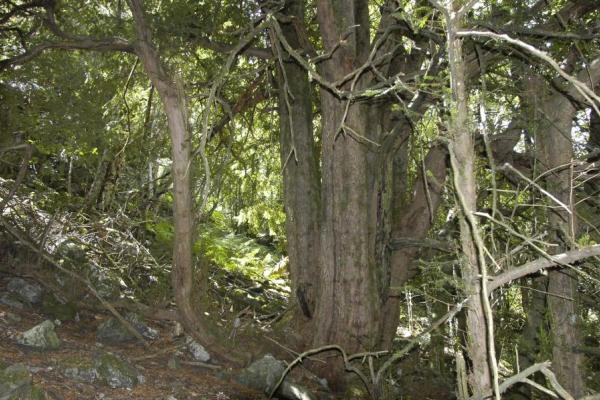
The word tejo (Yew tree in Spanish) comes from the old Castilian texo or taxo. Etymologically this term comes from the Latin word taxus in the first place however it has not been agreed yet on the term this Latin form derives from. Sometimes it is believed that the Latin word taxus comes from the Greek term taxis, which most probably means ‛row’ ‛arrangement’ and it might be related to the leaf lay out on branches, in a two-row pattern alongside twigs (for example, phyllotaxis or phyllotaxy is the name of the science that studies this arrangement of leaves). However other people state that taxus comes from the word taxon, which means ‛bow’ in Greek and therefore the name would come from the old-times bow making technique for which yew was used as the preferred wood. Thirdly, it is believed that taxus comes from the Greek toxon making direct reference to yew tree toxicity which was well known historically and feared by men.
The three versions turned out to be interesting and plausible at the same time. Nevertheless, this document reviews the different names of the yew tree and how this influenced the toponymy in the territories where the LIFE BACCATA Project is taking place with specific conservation actions to restore and upgrade the yew tree woods (habitat 9580*).
The yew tree names in Castilla y León
This is generally known as tejo in Castilla y León but it is also regarded as teixo, teixeiro and teixeira in the area which is further to the north-west, on the border with Galicia and Asturias. There are other meanings with very similar root that merge into the Asturias dialect: texu and tixu, although tesio and teijo are also familiar terms in the northern part of Leon.
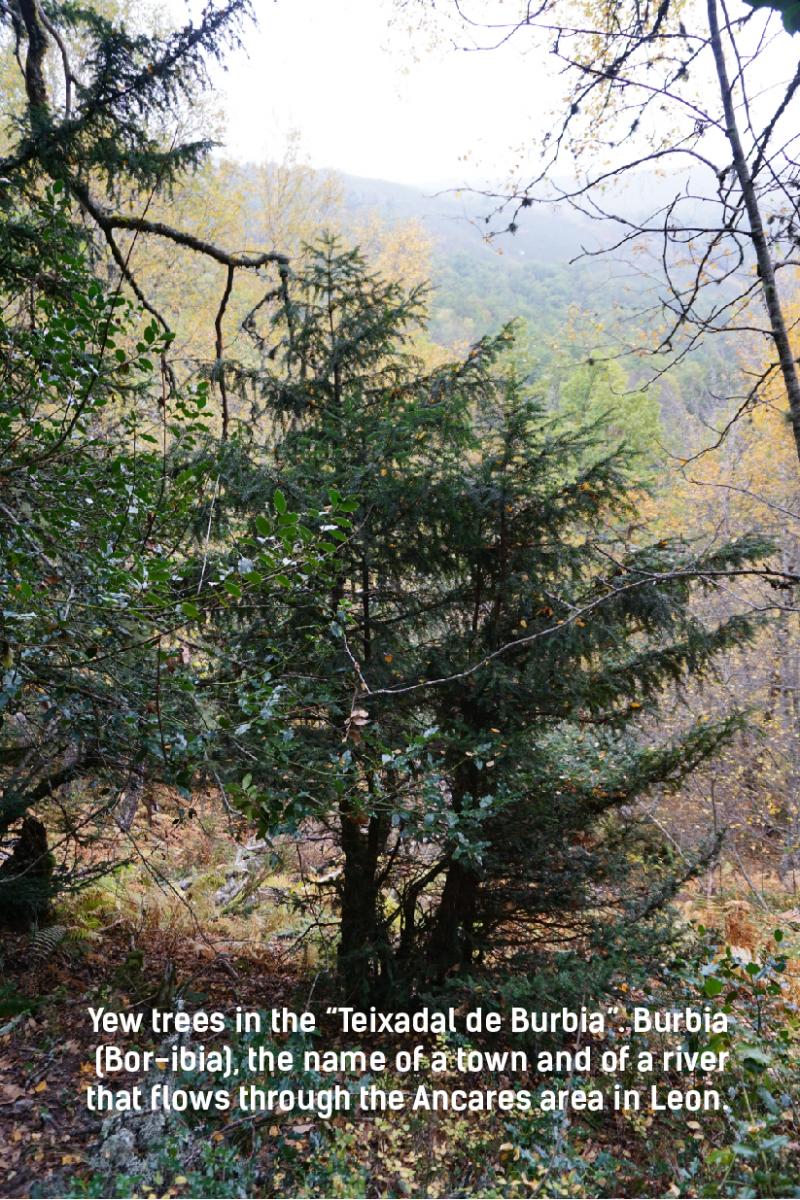 In some towns within the Sanabria area it is known as teyo, but also as Ramo. Meanwhile, two clearly-differentiated origins are found in the province of Burgos: The first one is used in the Sierra de Besante and it is related to the Castilian root: tejo negro. This name might be related to the name given to lime trees in some mountains of the province: tejo blanco (Cortes et al, 2000). In the County of Treviño this is known by the name of Agin, and its derivatives Hagin, Agina, Aginal etc., which are influenced by the Basque language. Several toponyms were gathered from these names in different districts of this region. Lastly the root Iba (Iva), also related to Ebur, Ibor, Ivor, Ibur and so on, may be the basis to create another name but it will depend on the author in question. For example, some claim Celtic roots are embedded —the most widely known and more likely to be— (please see Delahunty, 2002 or Hagueneder, 2007) or merely Mediterranean roots (García-Pérez, 2009). The names given to the yew tribes that lived in the Atlantic area in pre-Roman times, ‛Eburones’ or ‛Eburos’, seem to agree lexically speaking. Interestingly these meanings are common to emblematic areas within the Castilian-Leon mountains. For example, Burbia (image 1), in the Ancares area of León; Buron, on the Esla River Banks and close to Mampodre; Vega de Bur, close to Dehesa de Montejo, in the Palencia Mountain; or La Bureba, in Burgos.
In some towns within the Sanabria area it is known as teyo, but also as Ramo. Meanwhile, two clearly-differentiated origins are found in the province of Burgos: The first one is used in the Sierra de Besante and it is related to the Castilian root: tejo negro. This name might be related to the name given to lime trees in some mountains of the province: tejo blanco (Cortes et al, 2000). In the County of Treviño this is known by the name of Agin, and its derivatives Hagin, Agina, Aginal etc., which are influenced by the Basque language. Several toponyms were gathered from these names in different districts of this region. Lastly the root Iba (Iva), also related to Ebur, Ibor, Ivor, Ibur and so on, may be the basis to create another name but it will depend on the author in question. For example, some claim Celtic roots are embedded —the most widely known and more likely to be— (please see Delahunty, 2002 or Hagueneder, 2007) or merely Mediterranean roots (García-Pérez, 2009). The names given to the yew tribes that lived in the Atlantic area in pre-Roman times, ‛Eburones’ or ‛Eburos’, seem to agree lexically speaking. Interestingly these meanings are common to emblematic areas within the Castilian-Leon mountains. For example, Burbia (image 1), in the Ancares area of León; Buron, on the Esla River Banks and close to Mampodre; Vega de Bur, close to Dehesa de Montejo, in the Palencia Mountain; or La Bureba, in Burgos.
The yew tree names in the Basque Country
The yew tree is widely known in the Basque language especially by the names of Agin, Hagin, Hagina, Hagintze and Agiña. There is no certainty about the etymological origin of this word. Actually, some authors make several assumptions regarding different meanings that are not necessarily related with each other. For example, Guinea (1948) states that the yew’s name comes from the root Hagina (back tooth, molar) in the Basque language because its fruit wrapped in the aryl reminds that. There are other authors that relate it to the root Agin or Agintari, which means leader, leading, clearly alluding to the tree alleged superiority. Interestingly this statement agrees with other considerations made by other far off civilizations. For example, this agrees with the traditional indigenous culture from the North American Pacific area where the yew tree is the ‛boss of all bushes’. A similar meaning is found in the traditional culture of some areas of Japan.
There is also the possibility to relate it with the root Adín, which means ‛age, understanding, judgment’, which could be related to the roles it plays as tree of oath, of gatherings, as an entity that gives testimony of commitments made and as a tree with legal capacity, including religious functions. According to other meanings, Aguin may be related to the meaning of Agindu, Agintea and Agintaritza, that is “telling what to do, giving a command, promising” and this deviates relatively from ‛row and/or arrangement’ (in terms of its leaves layout in a two-row pattern) and interestingly other authors refer to it but focusing on its Latin root Taxus.
Probably Argin is an old-fashioned name for yew but it might have been mixed up with Hargin (quarryman). There are some toponyms, such as Argiñeta (necropolis) used in Elorrio, which clearly seems to be related to an origin based on the former connection between this tree and death.
The yew tree names in Galicia
In Galicia teixo is the Galician name most commonly used by almost anybody for yew, however there are other terms, namely teixeira or teixeiro, which are used relatively frequently. Likewise, there is a large number of toponyms that come from the yew tree’s Latin name (Taxus), such as, Teixeda, Teixedais, Teixedelos, Teixidelos, Teixedo, Teixeira, Teixeiro, Teixide, Teixido, Teixidón, Teixidos, Teixín, Teixiz, Teixo.
Such an abundance of toponyms suggests some hypotheses concerning the strong presence of yew trees in the past or at least its widespread popularity across Galicia and its close relation to the inhabitants. Furthermore, yew trees were part of the farmland and forestry landscape and the companion of countless rural houses in different population entities of varied nature, presided over the gardens of meaningful manor houses or at the church atrium and cemeteries across Galicia. In addition, the rather good number of the mentioned toponyms reveals the overall existence of this species in the tree-lined landscape, thus these refer to yew tree formations (Teixeda, Teixedal, Teixedelos, Teixidelos, Teixedo, Teixido), instead of only stand-alone or singular trees (Teixo, Teixín, Teixiz, Teixeiro, Teixeira).
Only occasionally was there any doubt that some terms may refer to the badger (Meles meles), known in Galicia by the names of teixugo or porco teixo. Toponyms such as, teixón, teixueira, teixugueira, teixoeira have been associated to this animal. Other hypotheses suggest that some toponyms that derive from the yew tree come from the transformation of names that were originally used to refer to those areas or facilities in which tiles were manufactured (telleira, telleiro)
Despite all the names mentioned here come from the Latin name Taxus, the potential existence of some Indo-European toponyms is considered. These would derive from names such as eburus, ivus or iva, from which the French name for yew (if) or the German name for yew (eibe) originate. In line with this, there is a list of names in Galicia that can be brought out among which A Pobra de Burón is the most representative. This is the name of a municipality that belongs to A Fonsagra, a town in Lugo. The abundance of yew trees in houses, manor houses, churches and cemeteries is to highlight in this district (some of the individuals are included in the Galician Catalogue of Singular Species). Moreover, yew trees are even found in natural forests to an important degree and some of them formed small yew woods. Nevertheless, it is possible to identify other names such as, Ibedo or Eibedo, which apparently share the same Indo-European etymological root, although some hypotheses suggests that they come from the term oliveto.
The Yew Tree Toponymy in Castilla y León
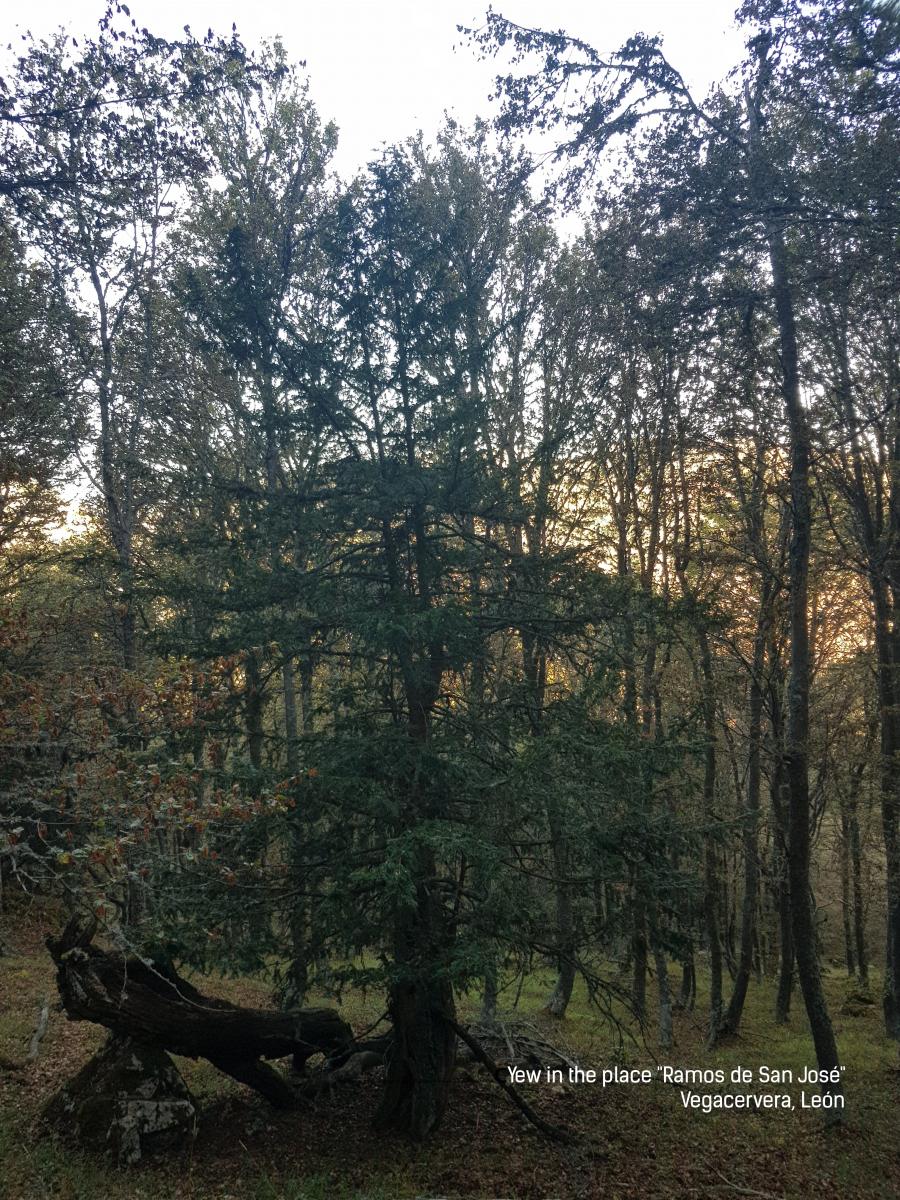
There are plenty of toponyms listed for places or entries related to the presence of yew in Castilla y León and this suggests the yew strong presence in its landscape and culture since time immemorial.
The following are some of the toponyms found:
The Yew Tree Toponymy in the Basque Country
As far as the Basque Country concerns, toponyms such as, Aginaga (Aiara), Agiñiga (Aguiñiga), Aginaga (Valle de Aiala) for the historical territory of Araba are worth mentioning. Arberas (2014) refers to Cumbre de los tejos and Agiñaga (Aiala) and Los tejos, Agindasolo, Aginandi, Aginandikozearra, Aginadipeko, Agintxikerra, Agiñaga, Agiñiga, Aginamendi and Sima del tejo.
The following were registered in Gipuzkoa: Aginaga (Eibar, Usurbil, Ibarranguelua, Lizarregiri), Agineta (Zumárraga), the megalithic complex of Agina (Oyarzun) or the Dolmen de Agiñaran (Alzania), and also Agiñarte, Agintza (Gueñes, Encartaciones) and Aginastegui (Pagoeta and Izarratitz).
For Bizkaia the following names were listed: Agina (Ibarra), Agiñalde and Agiñeta (Zeanuri), Necrópolis de Arguiñeta (Elorrio). According to the list of toponyms in the Basque language published by Néstor de Goikoetxea, Aginalde is the name given by a group of friends to an Alpine shelter that was built in the Campas of Arimekorta (Gorbea) to pay tribute to the yew tree that raises above the building and which witnessed old-times settlements.
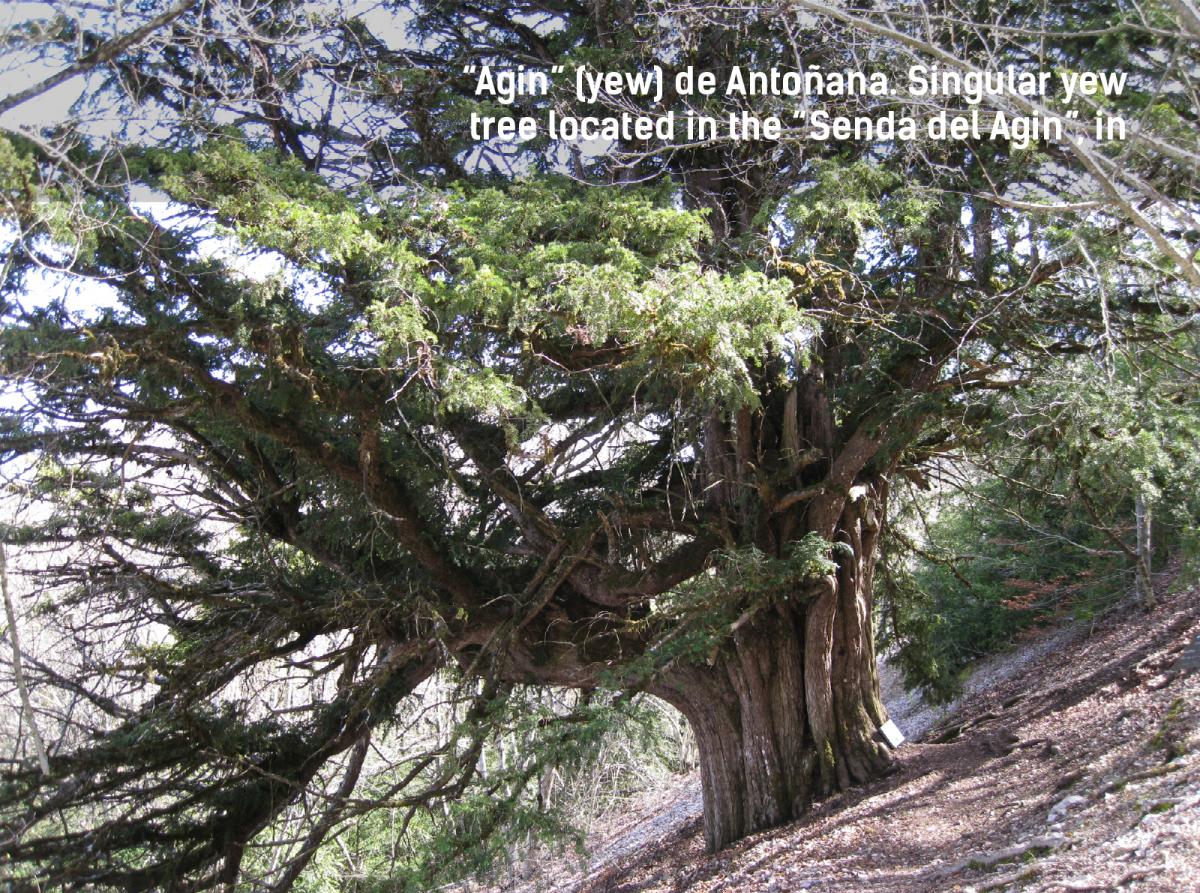 Surprisingly there are other toponyms related to the yew tree in other areas at the Cantabria coast with similar root, e.g. Aguines, in Salceda (Cantabria). Among others, A Aguiña (Padrón-Galicia) or the Asturian Aguino (Pola de Someiu) and Fontaguín (Braña de Perlunes) are listed in the text by Garcia (2009). The last place can be considered a landmark in Asturias symbolism and it is listed by Abella (2009). He tells us about the legend of a shepherd who stole the holy grail from a xana (an Asturian fairy from mythodology). While the xana was chasing the thieve, he was running crazy and howling, ‛Santiago de Angino, Valmé, that’s what I want for you!’
Surprisingly there are other toponyms related to the yew tree in other areas at the Cantabria coast with similar root, e.g. Aguines, in Salceda (Cantabria). Among others, A Aguiña (Padrón-Galicia) or the Asturian Aguino (Pola de Someiu) and Fontaguín (Braña de Perlunes) are listed in the text by Garcia (2009). The last place can be considered a landmark in Asturias symbolism and it is listed by Abella (2009). He tells us about the legend of a shepherd who stole the holy grail from a xana (an Asturian fairy from mythodology). While the xana was chasing the thieve, he was running crazy and howling, ‛Santiago de Angino, Valmé, that’s what I want for you!’
The Yew Tree Toponymy in the Galicia
For Galicia, the geographical nomenclature indicates that yew-related toponyms are especially abundant in this region, since more than 100 different toponym combinations can be obtained, all related to the term Taxus. Therefore, the influence of the yew tree on the Galicia toponymy is very heavy since its etymology is included in more than 200 records spread across the entire Galicia geography. It has been included in the toponymy used for paths (Camiño de Teixeira), the river system (Rego do Teixo, Carrozo das Teixeiras, Regueiro Teixeira, etc.) all terms related to the Continental orography (Pena Teixeiro, Coto dos Teixos, Valiña do Teixo, etc.), and the plant landscape (Os Teixiños, O Teixedal, etc.) as well as the farmland landscape (Agro das Teixeiras).
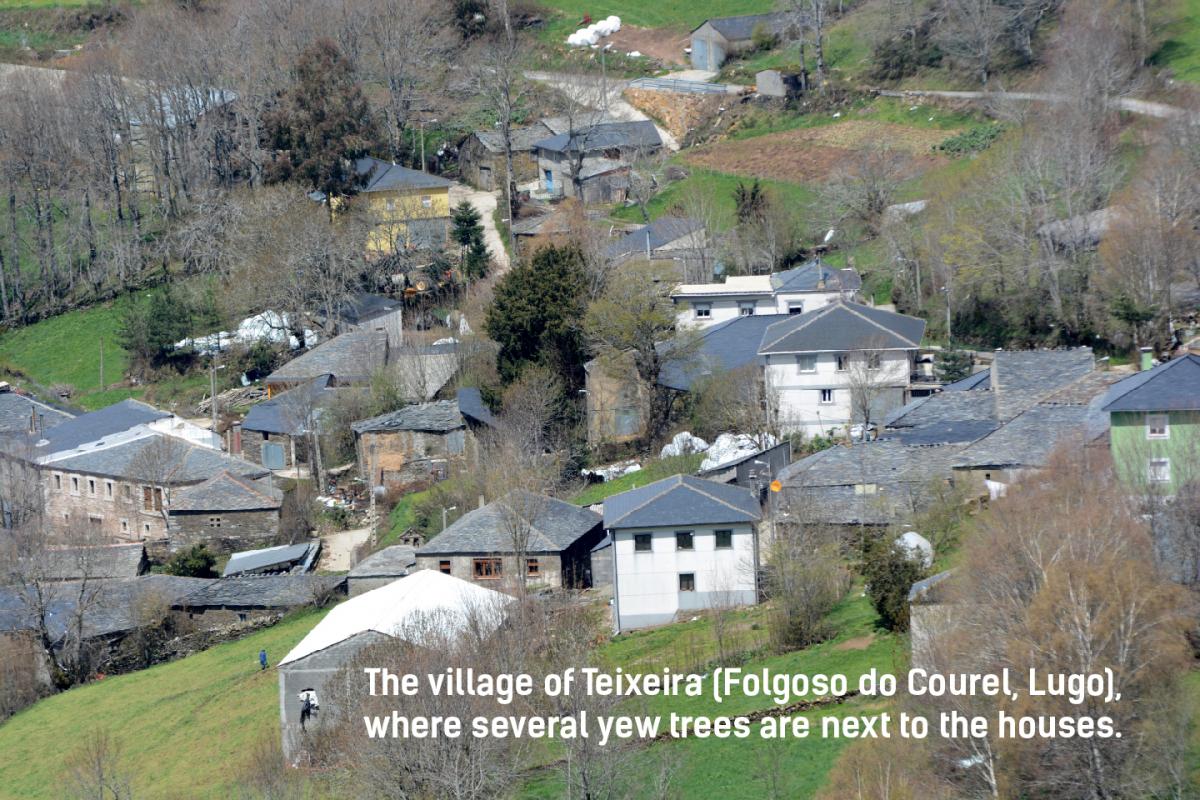
The high concentration of yew-related toponyms in Galicia can also be observed by the names given to towns and constructions themselves. Up to 59 singular entities, distributed among 4 Galicia provinces, can be identified in the database of some population entities. It includes Taxus and its etymology (O Teixeiro, Teixedo, Teixido, Teixidelo, A Teixeira, etc.). In this large group the most representative cases are those that designate an entire municipal area (the municipality of A Teixeira, in the district of Terra de Caldelas, in the province of Ourense), or the municipal capital itself (Teixeiro, the capital of the municipality of Curtis, in the province of A Coruña). It is also worth mentioning the ancient pilgrimage places where the whole symbolism of yew trees prevailed (Santo André de Teixido, a village in the municipality of Cedeira, in the province of A Coruña).
The survey conducted on the toponyms listed for places related to the yew tree presence in Galicia allows to rate the importance of this species in the nomenclature. Some toponyms (arranged by provinces) are listed below:
The yew-related toponymy is especially meaningful to municipalities of Galicia where LIFE BACCATA will implement the habitat 9580* conservation actions, in the municipal, communal woodlands (MVMC by the Spanish acronym) of Riocereixa (Pedrafita do Cebreiro, Lugo). In this case, the habitat 9580* will be restored by using Reproductive Genetic Material that comes from the MVMC itself. This material was collected from an area in the forest locally known as "Entre os Teixos" a toponym that unequivocally indicates a part of the mountain where there is an unusual concentration of yew trees.
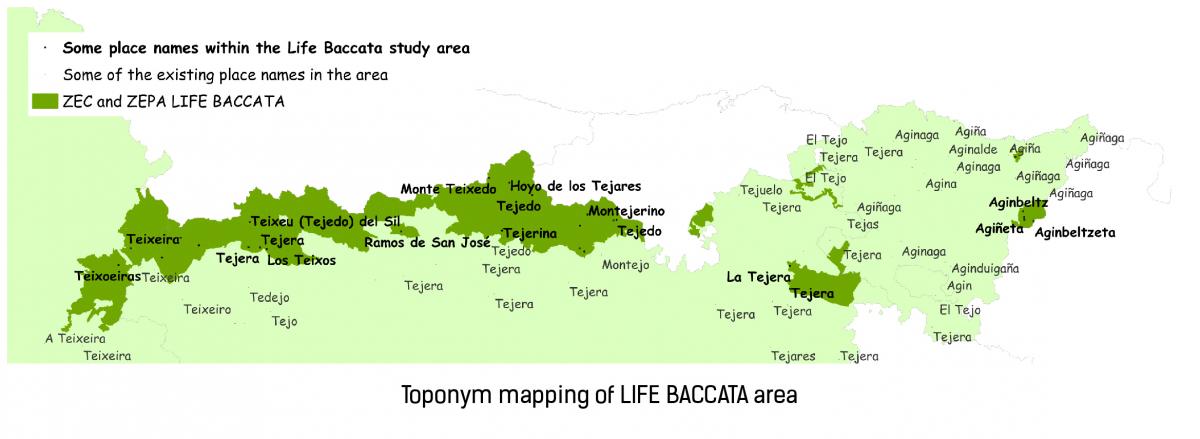
The three versions turned out to be interesting and plausible at the same time. Nevertheless, this document reviews the different names of the yew tree and how this influenced the toponymy in the territories where the LIFE BACCATA Project is taking place with specific conservation actions to restore and upgrade the yew tree woods (habitat 9580*).
The yew tree names in Castilla y León
This is generally known as tejo in Castilla y León but it is also regarded as teixo, teixeiro and teixeira in the area which is further to the north-west, on the border with Galicia and Asturias. There are other meanings with very similar root that merge into the Asturias dialect: texu and tixu, although tesio and teijo are also familiar terms in the northern part of Leon.
 In some towns within the Sanabria area it is known as teyo, but also as Ramo. Meanwhile, two clearly-differentiated origins are found in the province of Burgos: The first one is used in the Sierra de Besante and it is related to the Castilian root: tejo negro. This name might be related to the name given to lime trees in some mountains of the province: tejo blanco (Cortes et al, 2000). In the County of Treviño this is known by the name of Agin, and its derivatives Hagin, Agina, Aginal etc., which are influenced by the Basque language. Several toponyms were gathered from these names in different districts of this region. Lastly the root Iba (Iva), also related to Ebur, Ibor, Ivor, Ibur and so on, may be the basis to create another name but it will depend on the author in question. For example, some claim Celtic roots are embedded —the most widely known and more likely to be— (please see Delahunty, 2002 or Hagueneder, 2007) or merely Mediterranean roots (García-Pérez, 2009). The names given to the yew tribes that lived in the Atlantic area in pre-Roman times, ‛Eburones’ or ‛Eburos’, seem to agree lexically speaking. Interestingly these meanings are common to emblematic areas within the Castilian-Leon mountains. For example, Burbia (image 1), in the Ancares area of León; Buron, on the Esla River Banks and close to Mampodre; Vega de Bur, close to Dehesa de Montejo, in the Palencia Mountain; or La Bureba, in Burgos.
In some towns within the Sanabria area it is known as teyo, but also as Ramo. Meanwhile, two clearly-differentiated origins are found in the province of Burgos: The first one is used in the Sierra de Besante and it is related to the Castilian root: tejo negro. This name might be related to the name given to lime trees in some mountains of the province: tejo blanco (Cortes et al, 2000). In the County of Treviño this is known by the name of Agin, and its derivatives Hagin, Agina, Aginal etc., which are influenced by the Basque language. Several toponyms were gathered from these names in different districts of this region. Lastly the root Iba (Iva), also related to Ebur, Ibor, Ivor, Ibur and so on, may be the basis to create another name but it will depend on the author in question. For example, some claim Celtic roots are embedded —the most widely known and more likely to be— (please see Delahunty, 2002 or Hagueneder, 2007) or merely Mediterranean roots (García-Pérez, 2009). The names given to the yew tribes that lived in the Atlantic area in pre-Roman times, ‛Eburones’ or ‛Eburos’, seem to agree lexically speaking. Interestingly these meanings are common to emblematic areas within the Castilian-Leon mountains. For example, Burbia (image 1), in the Ancares area of León; Buron, on the Esla River Banks and close to Mampodre; Vega de Bur, close to Dehesa de Montejo, in the Palencia Mountain; or La Bureba, in Burgos. The yew tree names in the Basque Country
The yew tree is widely known in the Basque language especially by the names of Agin, Hagin, Hagina, Hagintze and Agiña. There is no certainty about the etymological origin of this word. Actually, some authors make several assumptions regarding different meanings that are not necessarily related with each other. For example, Guinea (1948) states that the yew’s name comes from the root Hagina (back tooth, molar) in the Basque language because its fruit wrapped in the aryl reminds that. There are other authors that relate it to the root Agin or Agintari, which means leader, leading, clearly alluding to the tree alleged superiority. Interestingly this statement agrees with other considerations made by other far off civilizations. For example, this agrees with the traditional indigenous culture from the North American Pacific area where the yew tree is the ‛boss of all bushes’. A similar meaning is found in the traditional culture of some areas of Japan.
There is also the possibility to relate it with the root Adín, which means ‛age, understanding, judgment’, which could be related to the roles it plays as tree of oath, of gatherings, as an entity that gives testimony of commitments made and as a tree with legal capacity, including religious functions. According to other meanings, Aguin may be related to the meaning of Agindu, Agintea and Agintaritza, that is “telling what to do, giving a command, promising” and this deviates relatively from ‛row and/or arrangement’ (in terms of its leaves layout in a two-row pattern) and interestingly other authors refer to it but focusing on its Latin root Taxus.
Probably Argin is an old-fashioned name for yew but it might have been mixed up with Hargin (quarryman). There are some toponyms, such as Argiñeta (necropolis) used in Elorrio, which clearly seems to be related to an origin based on the former connection between this tree and death.
The yew tree names in Galicia
In Galicia teixo is the Galician name most commonly used by almost anybody for yew, however there are other terms, namely teixeira or teixeiro, which are used relatively frequently. Likewise, there is a large number of toponyms that come from the yew tree’s Latin name (Taxus), such as, Teixeda, Teixedais, Teixedelos, Teixidelos, Teixedo, Teixeira, Teixeiro, Teixide, Teixido, Teixidón, Teixidos, Teixín, Teixiz, Teixo.
Such an abundance of toponyms suggests some hypotheses concerning the strong presence of yew trees in the past or at least its widespread popularity across Galicia and its close relation to the inhabitants. Furthermore, yew trees were part of the farmland and forestry landscape and the companion of countless rural houses in different population entities of varied nature, presided over the gardens of meaningful manor houses or at the church atrium and cemeteries across Galicia. In addition, the rather good number of the mentioned toponyms reveals the overall existence of this species in the tree-lined landscape, thus these refer to yew tree formations (Teixeda, Teixedal, Teixedelos, Teixidelos, Teixedo, Teixido), instead of only stand-alone or singular trees (Teixo, Teixín, Teixiz, Teixeiro, Teixeira).
Only occasionally was there any doubt that some terms may refer to the badger (Meles meles), known in Galicia by the names of teixugo or porco teixo. Toponyms such as, teixón, teixueira, teixugueira, teixoeira have been associated to this animal. Other hypotheses suggest that some toponyms that derive from the yew tree come from the transformation of names that were originally used to refer to those areas or facilities in which tiles were manufactured (telleira, telleiro)
Despite all the names mentioned here come from the Latin name Taxus, the potential existence of some Indo-European toponyms is considered. These would derive from names such as eburus, ivus or iva, from which the French name for yew (if) or the German name for yew (eibe) originate. In line with this, there is a list of names in Galicia that can be brought out among which A Pobra de Burón is the most representative. This is the name of a municipality that belongs to A Fonsagra, a town in Lugo. The abundance of yew trees in houses, manor houses, churches and cemeteries is to highlight in this district (some of the individuals are included in the Galician Catalogue of Singular Species). Moreover, yew trees are even found in natural forests to an important degree and some of them formed small yew woods. Nevertheless, it is possible to identify other names such as, Ibedo or Eibedo, which apparently share the same Indo-European etymological root, although some hypotheses suggests that they come from the term oliveto.
The Yew Tree Toponymy in Castilla y León

There are plenty of toponyms listed for places or entries related to the presence of yew in Castilla y León and this suggests the yew strong presence in its landscape and culture since time immemorial.
The following are some of the toponyms found:
| Province | Toponym |
| Ávila | Correra del tejo, Garganta Tejea, Garganta de Valdetajo, Puente de Valdetejo, Tejo de las Mulas, Arroyo de los Tejos, Los Tejos. |
| Burgos | Los Tejos, Vereda de los Tejos, Barranco de los tejus, Montija, Aginal de Arralde, Cueva del Agin. |
| León | Ramos de San José, Teixeu de Sil, Teixeu de Ancares, Teixeira, Cantexeira, Poula de Penoteixo, Valina do Teixo, Cascada del teixedal, el Pozo del Teixo, Arroyo Tegeo, El Ticheo, Arroyo del Teixadal, Ferrería de San Juan del Tejo, Arroyo de tejedo, Tedejo, Monte Texedo, San Juan del Tejo, Loma de las Tejedas, Hoyo de los Tejares, Majada de Tejedo, Mosqueiro, Monteviejo (probable). Yebra (also used in the Pyrenees portion of Huesca and which is similar to the English name ‛Yew’) |
| Palencia | Peña del Tejo, Dehesa de Montejo, Peña Tejedo, El Tejo bajero, Montejerinos. |
| Salamanca | Manantial del tejo. |
| Segovia | Los Tejos, Monte de los Tejos, Embalse de El Tejo, Arroyo de la Tejeda, Mata del Tejo. |
| Soria | El tejo (Monte), Barranco de los Tejos (Sámago). |
| Zamora | Los Tejos, Vega del Teyo, Teixedelo. |
As far as the Basque Country concerns, toponyms such as, Aginaga (Aiara), Agiñiga (Aguiñiga), Aginaga (Valle de Aiala) for the historical territory of Araba are worth mentioning. Arberas (2014) refers to Cumbre de los tejos and Agiñaga (Aiala) and Los tejos, Agindasolo, Aginandi, Aginandikozearra, Aginadipeko, Agintxikerra, Agiñaga, Agiñiga, Aginamendi and Sima del tejo.
The following were registered in Gipuzkoa: Aginaga (Eibar, Usurbil, Ibarranguelua, Lizarregiri), Agineta (Zumárraga), the megalithic complex of Agina (Oyarzun) or the Dolmen de Agiñaran (Alzania), and also Agiñarte, Agintza (Gueñes, Encartaciones) and Aginastegui (Pagoeta and Izarratitz).
For Bizkaia the following names were listed: Agina (Ibarra), Agiñalde and Agiñeta (Zeanuri), Necrópolis de Arguiñeta (Elorrio). According to the list of toponyms in the Basque language published by Néstor de Goikoetxea, Aginalde is the name given by a group of friends to an Alpine shelter that was built in the Campas of Arimekorta (Gorbea) to pay tribute to the yew tree that raises above the building and which witnessed old-times settlements.
 Surprisingly there are other toponyms related to the yew tree in other areas at the Cantabria coast with similar root, e.g. Aguines, in Salceda (Cantabria). Among others, A Aguiña (Padrón-Galicia) or the Asturian Aguino (Pola de Someiu) and Fontaguín (Braña de Perlunes) are listed in the text by Garcia (2009). The last place can be considered a landmark in Asturias symbolism and it is listed by Abella (2009). He tells us about the legend of a shepherd who stole the holy grail from a xana (an Asturian fairy from mythodology). While the xana was chasing the thieve, he was running crazy and howling, ‛Santiago de Angino, Valmé, that’s what I want for you!’
Surprisingly there are other toponyms related to the yew tree in other areas at the Cantabria coast with similar root, e.g. Aguines, in Salceda (Cantabria). Among others, A Aguiña (Padrón-Galicia) or the Asturian Aguino (Pola de Someiu) and Fontaguín (Braña de Perlunes) are listed in the text by Garcia (2009). The last place can be considered a landmark in Asturias symbolism and it is listed by Abella (2009). He tells us about the legend of a shepherd who stole the holy grail from a xana (an Asturian fairy from mythodology). While the xana was chasing the thieve, he was running crazy and howling, ‛Santiago de Angino, Valmé, that’s what I want for you!’ For Galicia, the geographical nomenclature indicates that yew-related toponyms are especially abundant in this region, since more than 100 different toponym combinations can be obtained, all related to the term Taxus. Therefore, the influence of the yew tree on the Galicia toponymy is very heavy since its etymology is included in more than 200 records spread across the entire Galicia geography. It has been included in the toponymy used for paths (Camiño de Teixeira), the river system (Rego do Teixo, Carrozo das Teixeiras, Regueiro Teixeira, etc.) all terms related to the Continental orography (Pena Teixeiro, Coto dos Teixos, Valiña do Teixo, etc.), and the plant landscape (Os Teixiños, O Teixedal, etc.) as well as the farmland landscape (Agro das Teixeiras).

The high concentration of yew-related toponyms in Galicia can also be observed by the names given to towns and constructions themselves. Up to 59 singular entities, distributed among 4 Galicia provinces, can be identified in the database of some population entities. It includes Taxus and its etymology (O Teixeiro, Teixedo, Teixido, Teixidelo, A Teixeira, etc.). In this large group the most representative cases are those that designate an entire municipal area (the municipality of A Teixeira, in the district of Terra de Caldelas, in the province of Ourense), or the municipal capital itself (Teixeiro, the capital of the municipality of Curtis, in the province of A Coruña). It is also worth mentioning the ancient pilgrimage places where the whole symbolism of yew trees prevailed (Santo André de Teixido, a village in the municipality of Cedeira, in the province of A Coruña).
The survey conducted on the toponyms listed for places related to the yew tree presence in Galicia allows to rate the importance of this species in the nomenclature. Some toponyms (arranged by provinces) are listed below:
| Province | Toponym |
| A Coruña | O Teixeiro, Teixedo, Teixido, Teixidelo, O Penedo de Teixeiro, Teixín, Teixedelos, Teixidón, O Teixeiro de Arriba, A Ponte de Teixeiro |
| Lugo | A Ponte do Teixo, O Teixo, O Teixeiro, Teixeda, Teixeira, Os Teixidos, A Teixeira, Os Teixós, Teixeira de Abaixo, Teixeira de Arriba, A Ponteixeda, Castro de Teixeiro |
| Ourense | A Teixeira, Teixido, O Teixedo, |
| Pontevedra | A Teixeira, As Teixiñas |




